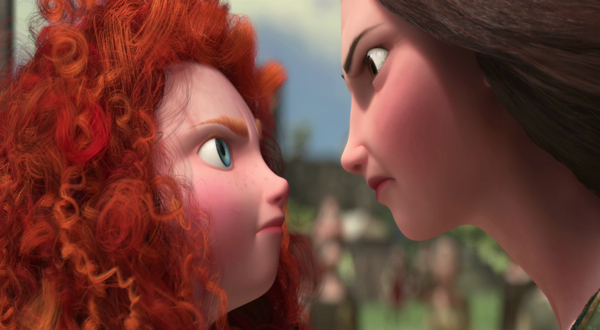Movie review by Greg Carlson
Pixar has passed the Bechdel Test before, perhaps most notably in “The Incredibles,” a movie that still contends with problematic gender norms and stereotyping, but “Brave” is the first of the studio’s features to place a female protagonist – and a mother-daughter relationship – at the very heart of the story. And while Pixar will likely never meet the track record of Hayao Miyazaki at Studio Ghibli (posting eight of nine films with a lead female character), hopefully “Brave” will mark the beginning of a period in which women in American animation are better represented on camera and behind it. The “creative differences” that initiated the ouster of original “Brave” story creator and director Brenda Chapman, who worked on the project for six years, serve as a telling reminder that the film industry still has a very long way to go.
Some hardliners have already criticized Merida’s station as a princess, but given the character’s refusal to acquiesce to arranged marriage, and the 10th century setting in a fairytale Scotland teeming with magic, “Brave” deserves the dispensation that separates its heroine from the ranks of boy-crazy royals or royals-to-be in so many Disney movies. One imagines that many girls, and plenty of boys, will be captivated by the archery contest in which Merida applies a technicality in the clan rulebook to announce, “…I’ll be shooting for my own hand.” Featured prominently in the film’s trailers, this sequence pays homage to the parallel scene in “The Adventures of Robin Hood,” and is staged with the same kind of lovely detail and charm that accompanied the moment in the classic 1938 swashbuckler.
Complementing Merida’s considerable skill with a bow and arrow, “Brave” also imbues the character and plot with echoes of Atalanta, the fierce warrior of Greek mythology who, after being abandoned at birth because she was not born male, was initially raised by a she-bear. “Brave” avoids overt pronouncements on the subject of gender disappointment, and King Fergus very clearly adores and encourages his first-born child, but with the inclusion of a competition in which Merida is a prize to be won, the film imitates the tale of Atalanta’s famous footrace. More intriguing yet is the link to the legend of Gelert, one of folklore’s most chilling and heartbreaking tales. The “Brave” variation cancels the unthinkable cruelty of Gelert’s martyrdom, but Merida’s horror at the thought of placing her mother in harm’s way resonates with the kind of guilt unique to the bonds of family.
As “Brave” unfolds, Queen Elinor emerges alongside Merida as a character of substantial dimension, and the depiction of the regal matriarch in her ursine form is a feat of technical brilliance that rivals the stunning singularity of Merida’s flaming orange curls. Initially, Merida’s privileged point-of-view serves to paint her mother as a strict killjoy and barrier to long-term happiness, but once the result of Merida’s foolhardy indiscretion occurs, both mother and daughter begin to alter their previous behavior, working together to prevent a backfired spell from turning into a permanent curse. Not everyone will applaud the movie’s conventional eagerness to neatly restore balance to a traditional portrait of social harmony and equilibrium, but keep in mind that at least the happily-ever-after of “Brave” does not include wedding bells.
